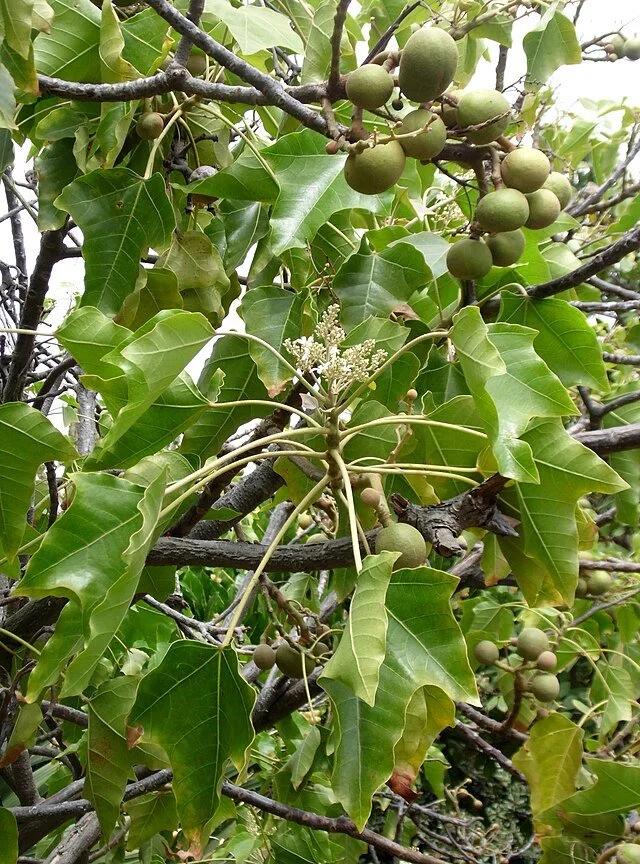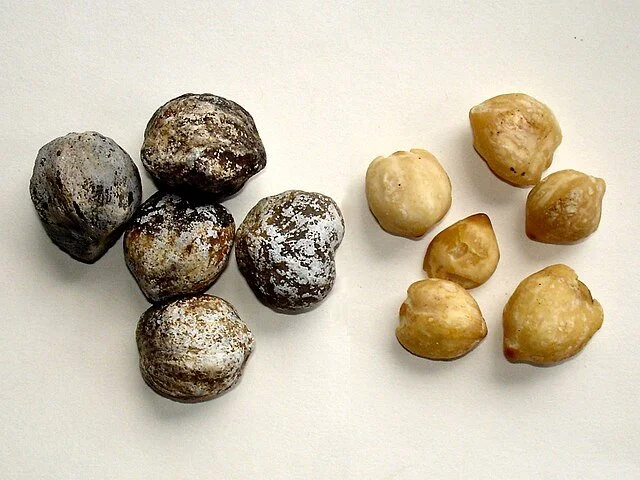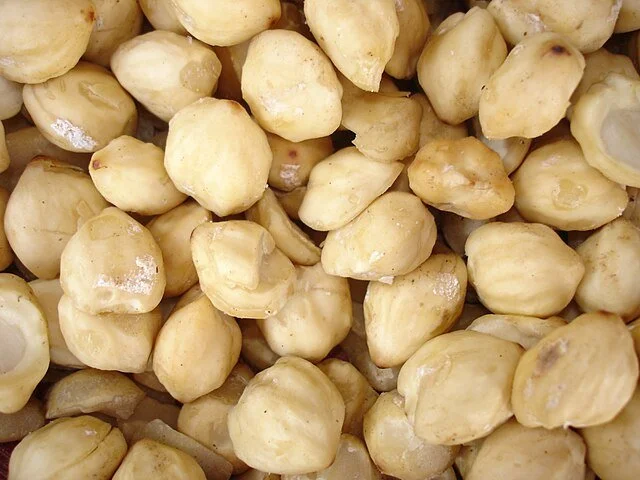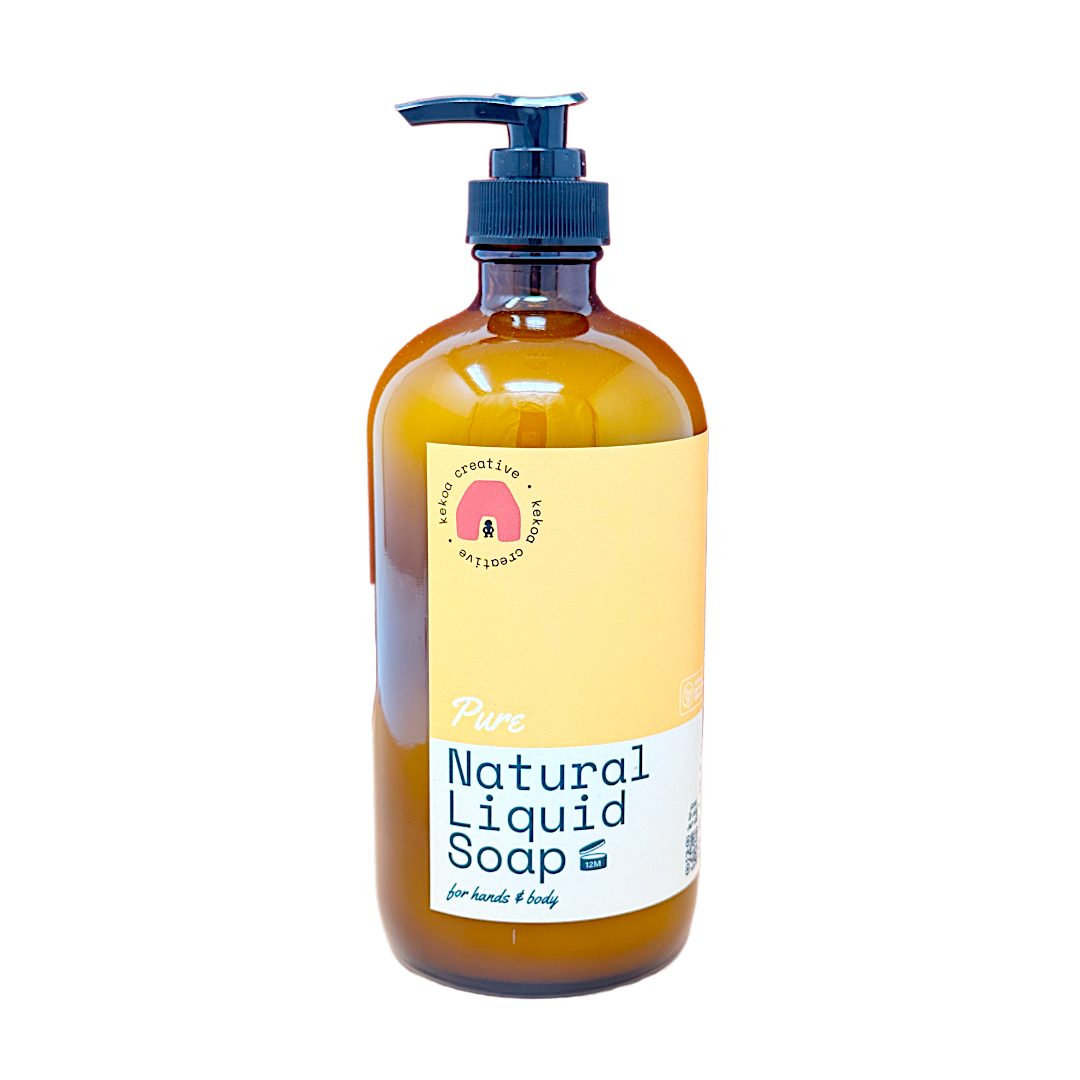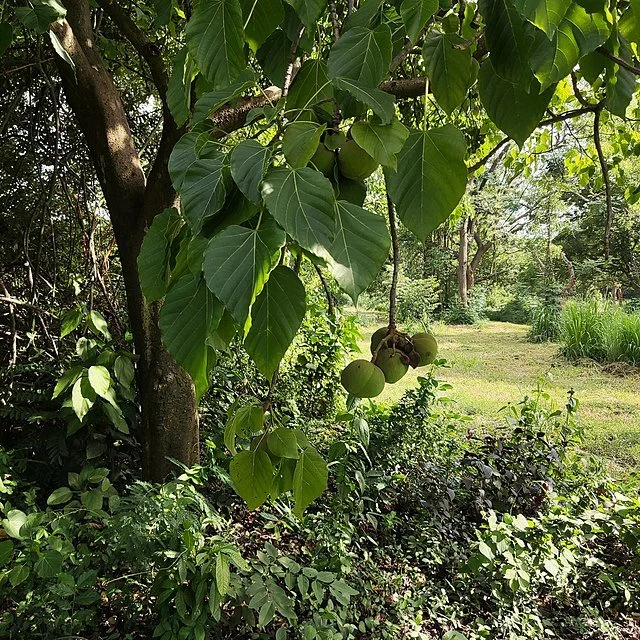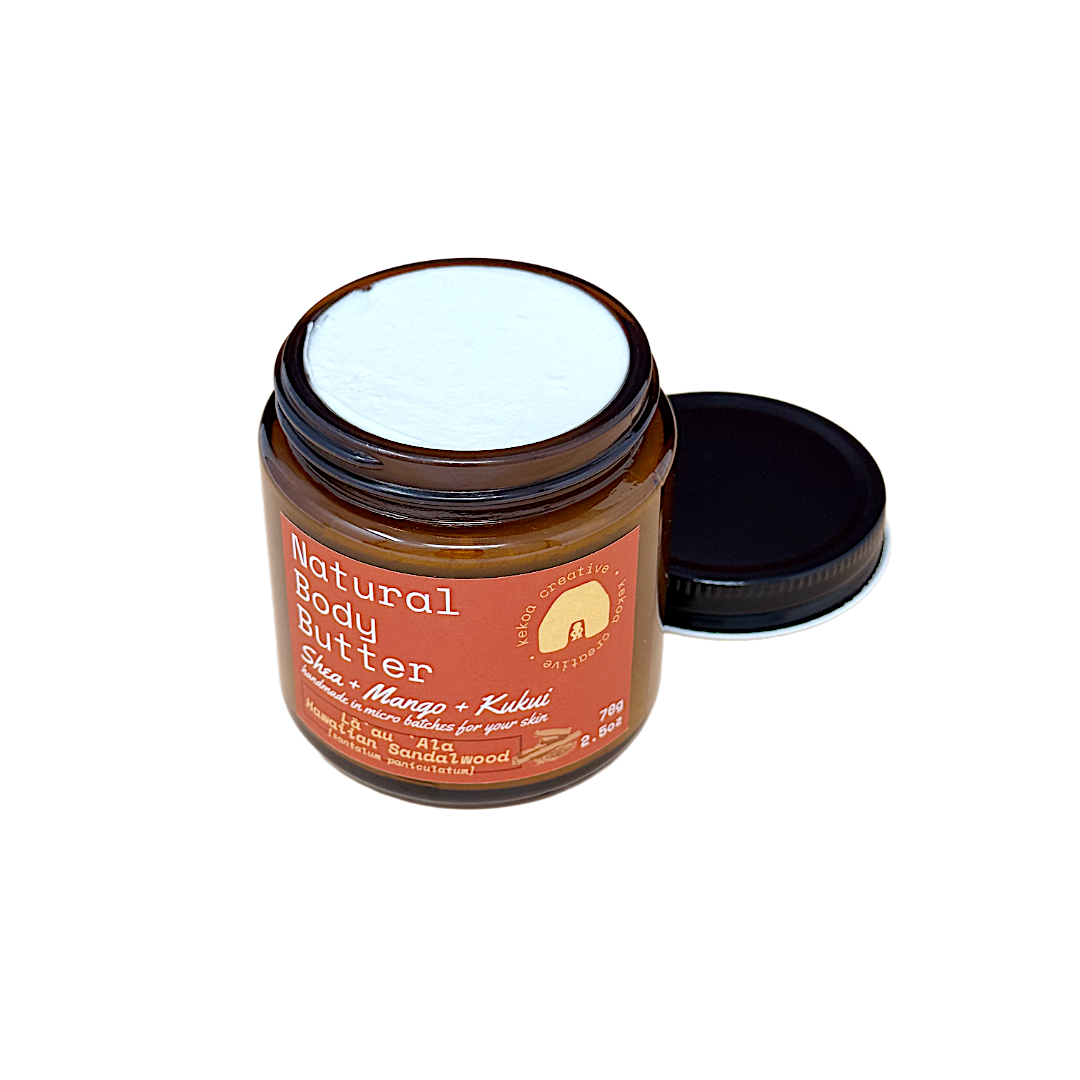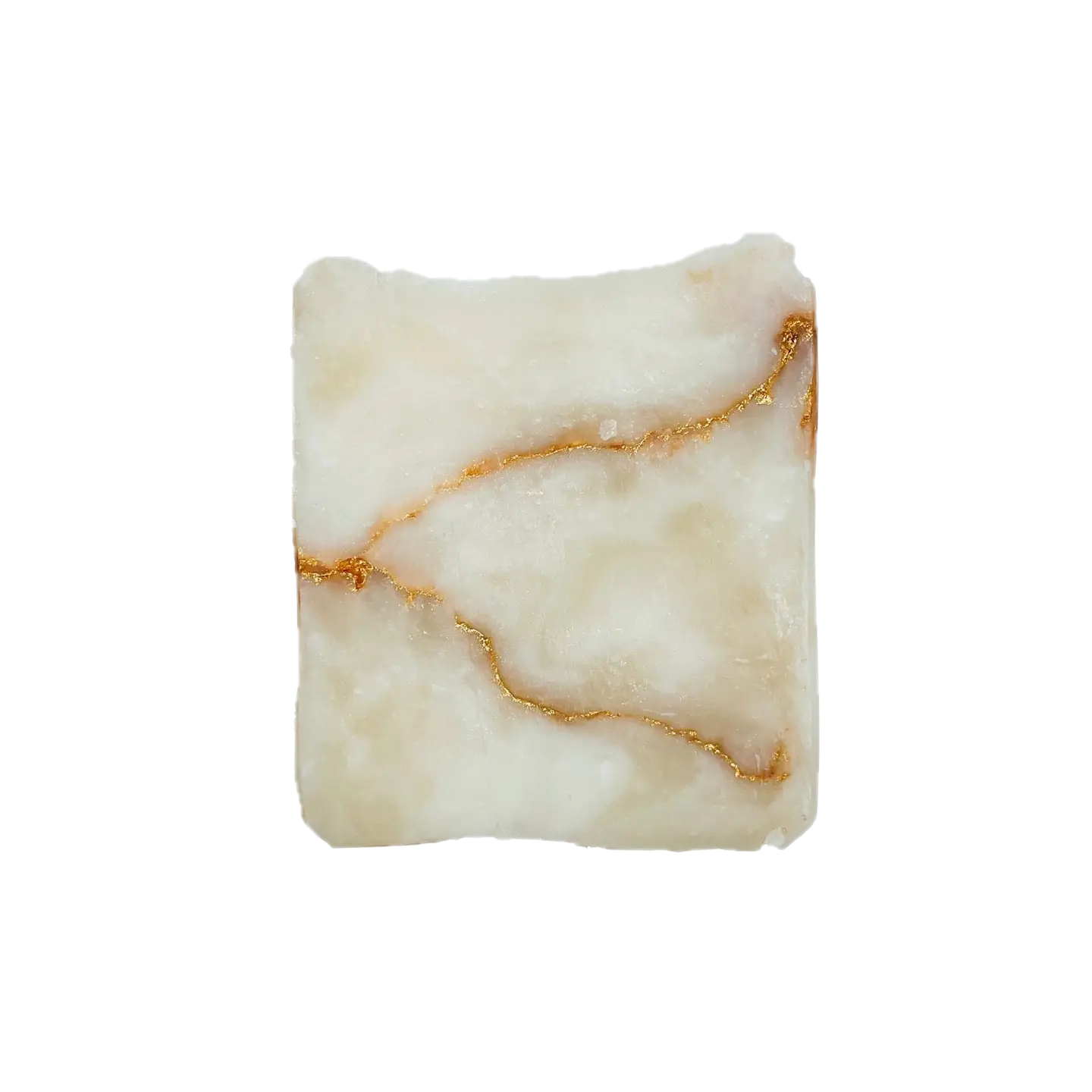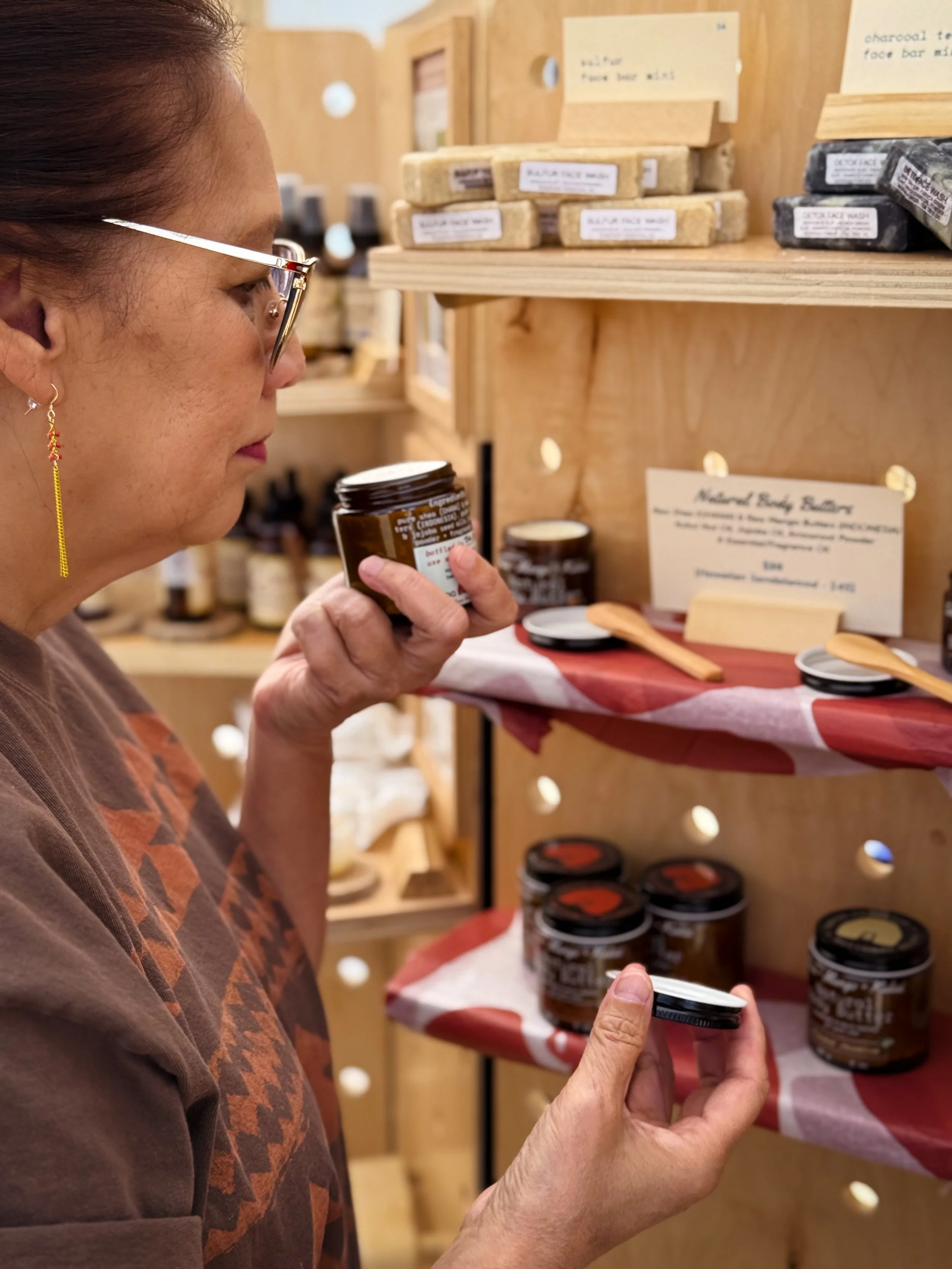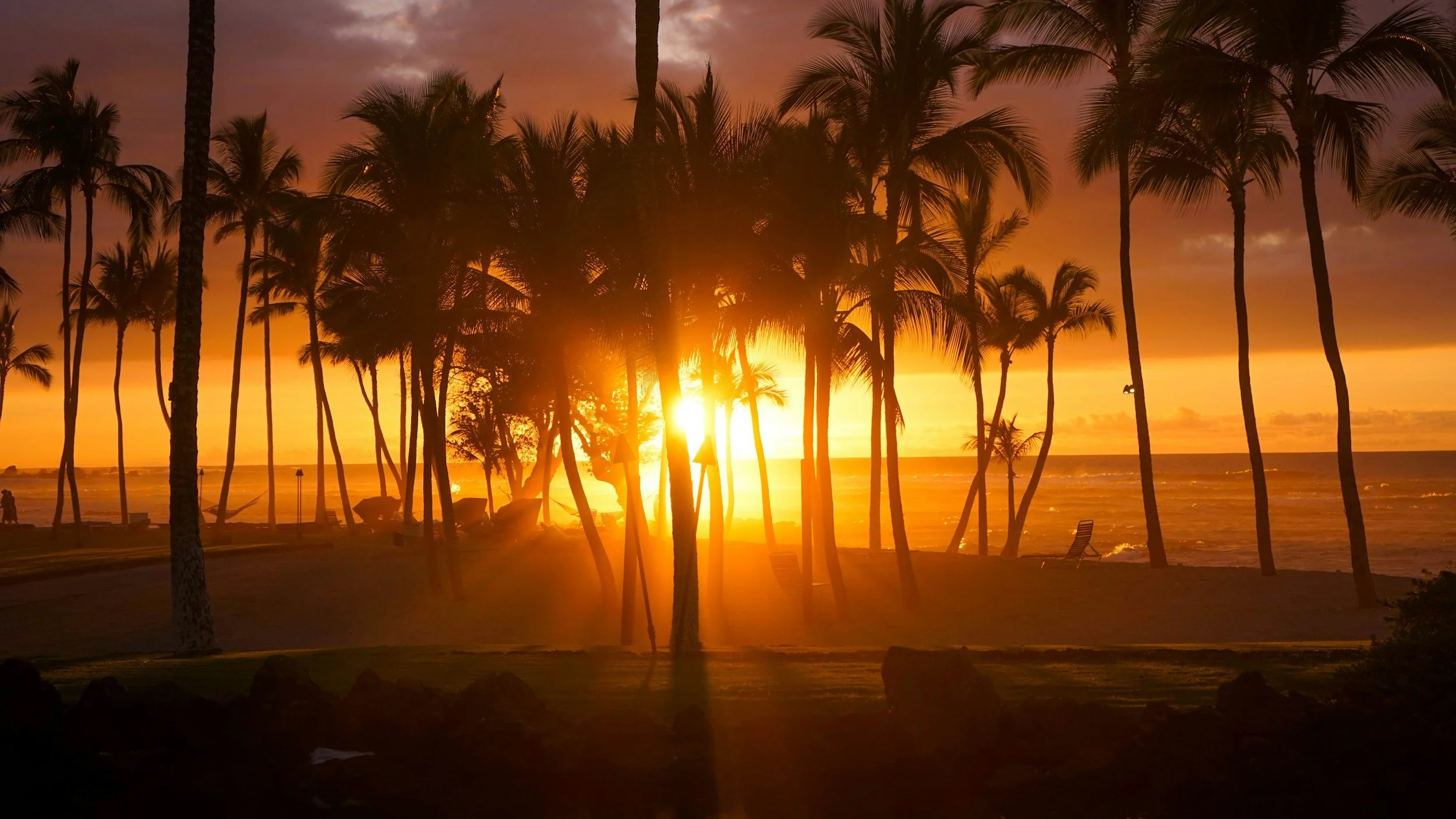Kukui: The Tree of Light, Healing, and knowledge
Lama kukui, kukui tree with wood, leaves, flower, and fruit (nuts) visible.
Aleurites moluccana.
The kukui tree (Aleurites moluccanus) stands as one of the most culturally and practically significant plants in Hawaiian tradition. Known as lama kukui (the light tree), kukui has provided—and continues to provide—kānaka ʻōiwi with light, medicine, nutrition, and spiritual guidance for generations. From the hua kukui (kukui nuts) that once lit homes and guided travelers, to the lau kukui (kukui leaves) used in traditional healing practices that continue today, to the rich ʻaila kukui (kukui nut oil) that nourishes skin, this tree embodies the Hawaiian value of pono—balance, reciprocity, and living in right relationship with the natural world.
At Kekoa Creative, ʻaila kukui is a cornerstone ingredient in our body care products. But before we explore its modern benefits, it's essential to understand the deep cultural roots and traditional knowledge that make kukui so much more than just an ingredient—it's a connection to ancestral wisdom, a symbol of enlightenment, and a gift from the ʻāina.
Cultural and Historical Significance: Kukui as Light and Guidance
Hua kukui, kukui nuts, candlenuts. Left: unshelled, Right: shelled.
Aleurites moluccana.
In Hawaiian life, kukui serves countless purposes. The name lama kukui translates to "light tree" or "torch tree," reflecting one of its most important uses: providing light. The oil-rich kukui nuts were—and in some cultural practices still are—strung together on coconut midribs to create kukui nut candles. When lit, each nut burns for several minutes, providing light for evening activities, ceremonies, and navigation. The phrase "kukui hele pō" (traveling light of the night) speaks to kukui's role in guiding people through darkness—both literally and metaphorically.
Kukui also represents enlightenment and knowledge. Just as the tree provides physical light, it symbolizes the illumination of understanding and wisdom. This symbolism extends to lei kukui, which are worn by aliʻi (chiefs) and kahuna (experts, priests) as symbols of guidance, protection, and spiritual clarity. Lei kukui are not casual adornments—they carry meaning and mana (spiritual power).
Beyond light and symbolism, kukui plays practical roles in daily life:
Canoe building: Kukui wood is used for canoe parts, and kukui sap serves as a sealant and waterproofing agent
Kapa making: ʻAila kukui is mixed with natural pigments to create dyes for kapa (bark cloth)
Fishing: Roasted kukui nuts are chewed and spit into the water to calm the surface, making it easier to see fish below
Traditional food: The roasted nut kernel is ground to create inamona, a traditional seasoning commonly eaten with fish and still enjoyed today with ahi poke
Traditional medicine: Kukui is used to treat a wide range of ailments (more on this below)
The kukui tree itself is considered the kinolau (physical embodiment) of Lono, the akua associated with rain, agriculture, fertility, and peace. Kukui is also a kinolau shared with Kamapuaʻa, a kupua (supernatural being) who is one of the descendant beings within the Lono genealogy of akua and kupua. This connection reinforces kukui's role as a plant that bridges the physical and spiritual worlds.
Traditional Uses: Medicine, Nutrition, and Protection
Lau kukui, kukui leaves, candlenut leaves.
Aleurites moluccana.
Kukui is a vital part of lāʻau lapaʻau (Hawaiian herbal medicine), both historically and in contemporary practice. Different parts of the tree are used to address various health concerns:
ʻAila Kukui (Kukui Nut Oil)
Applied topically to soothe dry, cracked, or irritated skin
Used to treat sunburn and minor burns
Massaged into the body to relieve muscle aches and joint pain
Applied to the scalp and hair for moisture and shine
Kukui Leaves (Lau kukui)
Leaves are steamed or heated and applied as poultices for swelling, inflammation, and pain
Leaf infusions are used for various internal ailments
Kukui Nut Kernel (Hua kukui)
The nut meat is consumed in small amounts as a laxative
Roasted and ground nuts create inamona, a nutritious seasoning rich in healthy fats
Roasted nuts provide nutrition and essential fatty acids
Traditional lāʻau lapaʻau is practiced by trained kahuna lāʻau lapaʻau (healing experts) who understand proper preparation, dosage, and application. These practices are passed down through generations and are deeply connected to pule (prayer), protocol, and relationship with the ʻāina. Today, many kānaka ʻōiwi continue to learn, practice, and revitalize these healing traditions as part of cultural reclamation and wellness.
Kukui also serves a protective function. Lei kukui are believed to offer spiritual protection to the wearer, and kukui trees planted near homes are thought to provide shelter and safety for the family.
ʻAila Kukui: Traditional Wisdom Meets Modern Body Care
Kukui nuts, candle nuts before being cold-pressed into oil.
Aleurites moluccana.
Today, ʻaila kukui is celebrated in natural body care for the same reasons it has been valued for generations: it is deeply nourishing, fast-absorbing, and gentle on all skin types. Modern research has confirmed what kānaka ʻōiwi have known for generations—ʻaila kukui is exceptionally beneficial for skin health.
Nutritional Profile and Fatty Acid Composition
ʻAila kukui is rich in essential fatty acids, including:
Linoleic acid (omega-6): 35-45%
Alpha-linolenic acid (omega-3): 25-35%
Oleic acid (omega-9): 15-25%
These fatty acids are critical for maintaining the skin's moisture barrier, reducing inflammation, and promoting healing. The high concentration of linoleic and linolenic acids makes ʻaila kukui particularly effective for:
Restoring compromised skin barriers: Essential for dry, sensitive, or eczema-prone skin
Anti-inflammatory action: Omega-3 and omega-6 fatty acids help calm redness and irritation
Cell regeneration: Supports healthy skin turnover and healing
Lightweight penetration: The molecular structure allows deep absorption without greasiness
Benefits for Skin and Hair
Fast-absorbing and non-greasy: Unlike heavier oils, ʻaila kukui absorbs quickly, making it ideal for daily use
Deeply moisturizing: Provides long-lasting hydration without clogging pores
Soothing and anti-inflammatory: Helps calm irritated, sensitive, or inflamed skin
Supports skin barrier function: Strengthens the skin's natural protective layer, especially important during cooler, drier months
Suitable for all skin types: From dry to oily, ʻaila kukui balances and nourishes without causing breakouts
Hair and scalp health: Penetrates the hair shaft to provide moisture, shine, and protection against breakage
Saponification and Gentle Soap Formulation
One of the remarkable properties of ʻaila kukui is how it saponifies—the chemical process by which oils are transformed into soap when combined with an alkali (such as lye). ʻAila kukui has a saponification valuethat results in a mild, gentle soap with excellent skin-conditioning properties.
When ʻaila kukui is used in soap making, it contributes:
Gentle cleansing: Creates a soap that cleanses without stripping the skin's natural oils
Creamy, stable lather: Produces a soft, luxurious lather that feels nourishing
Moisturizing properties: Leaves skin feeling soft and hydrated, not tight or dry
Low irritation potential: Ideal for sensitive skin and daily use
This is why we chose ʻaila kukui as a key ingredient in our natural liquid soap formulation, blending it with:
Olive oil: For additional moisturizing and gentle cleansing
Jojoba oil: To balance and protect the skin's natural barrier
Coconut oil: For cleansing power and lather
This blend creates a soap that cleanses effectively while honoring the skin's natural balance—a formulation rooted in both traditional knowledge and modern understanding of skin health. We currently offer our natural liquid soap in two variations: Pure (unscented) for those who prefer fragrance-free cleansing, and Pomander (an exclusive holiday season offering available through the end of the year), featuring warm notes of clove, cinnamon, and citrus. New scents will be introduced in spring 2026.
Seasonal Body Care
As we move into makahiki season (autumn and winter), our skin faces new challenges: cooler temperatures, lower humidity, and indoor heating all contribute to dryness and irritation. ʻAila kukui is an ideal ingredient for this time of year, providing the deep moisture and protection your skin needs without feeling heavy or greasy.
Sustainability: Kukui as a Renewable Resource
Kukui trees are remarkably abundant and fast-growing. A mature kukui tree can produce thousands of nuts each year, and the trees thrive in a variety of environments across Hawaiʻi. This natural abundance makes kukui a sustainable and renewable resource when harvested responsibly.
At Kekoa Creative, we prioritize sourcing ʻaila kukui from suppliers who practice ethical and sustainable harvesting. This means:
Wild-harvested or sustainably cultivated kukui nuts
No harmful chemicals or pesticides used in processing
Support for Hawaiian farmers and land stewards whenever possible
Cold-pressed extraction methods that preserve the oil's nutritional integrity
Kukui's sustainability is also reflected in its minimal waste. Traditionally and today, nearly every part of the kukui tree is used—nuts for oil, light, and food (inamona), leaves for medicine, wood for building, sap for sealing. This holistic use of resources is a model for the kind of sustainable practices we strive to uphold at Kekoa Creative.
Kekoa Creative Products: Kukui in Our Body Care Line
ʻAila kukui is a key ingredient in several Kekoa Creative products, chosen specifically for its cultural significance, skin benefits, and alignment with our values of sustainability and mālama.
Body Butter Collection
Our body butters feature ʻaila kukui alongside organic shea butter, mango butter, and jojoba oil to create a rich, nourishing formula that absorbs beautifully and provides long-lasting moisture. For the hāʻule lau (autumn) season, we offer three variations:
Pīkake (Jasmine): Floral and uplifting
Lāʻau ʻAla (Sandalwood): Warm and grounding, featuring Hawaiian sandalwood
Pomander: Seasonal warmth with notes of clove, cinnamon, and citrus—perfect for autumn and winter
Each 2 oz body butter is hand-crafted in small batches and packaged in compostable materials.
Natural Liquid Soap
Our natural liquid soap features a carefully crafted blend of ʻaila kukui, olive oil, jojoba oil, and coconut oil. This formulation creates a gentle, moisturizing cleanser that respects your skin's natural balance while providing effective cleansing. Perfect for hands, body, and daily use. Currently available in:
Pure (Unscented): Gentle, fragrance-free cleansing for sensitive skin or those who prefer no added scent
Pomander: An exclusive holiday season offering (available through the end of the year) with warm, comforting notes of clove, cinnamon, and citrus
New scents will be introduced in spring 2026.
Keālia Organics Body Bars
We're proud to carry Keālia Organics body bars, which also feature ʻaila kukui. Keālia Organics is a woman-owned business that supports Hawaiian farmers and uses locally sourced, organic ingredients. Their body bars are gentle, nourishing, and perfect for daily cleansing without stripping your skin's natural oils.
Hoʻōla Salve
Our hoʻōla salve (hoʻōla means "to heal" or "to restore") is a multi-purpose healing balm that includes both lāʻau ʻala, endemic Hawaiian sandalwood, as well as ʻaila kukui for its soothing, anti-inflammatory properties. Use it on dry patches, minor cuts and scrapes, cuticles, or anywhere your skin needs extra care.
Wearable Moʻolelo: Kukui in Our Trash Tee Designs
Kukui's cultural significance extends beyond body care—it's also featured in our trash tee designs. The "kaʻi ka puaʻa i luna o Hāʻupu, e ua ana" trash tee features a pattern of lālā kukui (kukui branches), hua kukui (kukui nuts), and lau kukui (kukui leaves).
This design is more than decorative—it's wearable moʻolelo. The pattern references a traditional Hawaiian saying and connects to the landscape, weather patterns, and cultural knowledge of place. By wearing this design, you carry a piece of Hawaiian knowledge and cultural identity with you.
Our trash tees are made from reclaimed waste cotton (sourced from Everybody.World) and printed with water-based inks and Algae Ink™, a biodegradable, sustainable alternative to traditional petroleum-based inks. Each tee is a statement of slow fashion, cultural authenticity, and environmental responsibility.
Kukui and the Hawaiian Diaspora: A Cultural Bridge
For kānaka ʻōiwi living outside of Hawaiʻi—in the diaspora—maintaining connection to culture can be challenging. Physical distance from the ʻāina, family, and community can create a sense of disconnection and longing.
Using ʻaila kukui in daily body care rituals offers a tangible way to stay connected to Hawaiian culture and ancestral knowledge, no matter where you live. When you smooth kukui-infused body butter onto your skin, you're not just moisturizing—you're engaging in a practice that connects you to generations of kānaka who have used—and continue to use—this plant for healing, nourishment, and light.
This is part of what makes Kekoa Creative's work so meaningful. We're not just selling products—we're offering tools for cultural connection, self-care as mālama kino, and ways to honor Hawaiian knowledge in everyday life.
Shop Kukui Products for both seasonal and all-year Skin Protection
As the weather shifts and the air grows cooler, your skin needs extra support. Our kukui-infused body care products provide the deep moisture, protection, and nourishment your skin craves during autumn and winter—all while honoring Hawaiian cultural knowledge and sustainable practices.
Shop our kukui collection:
Body Butter (Pīkake, Lāʻau ʻAla, Pomander)
Natural Liquid Soap (Pure, Pomander)
Keālia Organics Body Bars
Hoʻōla Salve
We also invite you to share this article with others who are interested in:
Hawaiian cultural knowledge and plant wisdom
Natural, plant-based skincare
Sustainable, ethical body care products
Cultural connection through daily rituals
The more we share these moʻolelo and practices, the more we contribute to the protection and revitalization of Hawaiian knowledge.
Mahalo nui for taking the time to learn about kukui—a plant that has nourished, healed, and guided kānaka ʻōiwi for generations. May kukui continue to bring light, healing, and connection to your life.Aloha nō,Kekoa.ʻŌlelo Hawaiʻi Glossary
ʻĀina: Land, earth; that which feeds
ʻAila kukui: Kukui nut oil
Akua: Deities; personifications of natural orders and phenomena
Aliʻi: Chiefs, leaders
Hoʻōla: To heal, restore, save
Hua kukui: Kukui nut
Inamona: Traditional Hawaiian seasoning made from roasted, ground kukui nuts, salt, and sometimes chili pepper
Kahuna: Expert, priest, specialist in any field
Kahuna lāʻau lapaʻau: Traditional Hawaiian healing expert; herbalist
Kamapuaʻa: Kupua (supernatural being) within the Lono genealogy; shares many kinolau with Lono
Kānaka ʻōiwi: Native Hawaiians (literally "people of the bone")
Kapa: Traditional Hawaiian bark cloth
Kinolau: Physical embodiment of an akua in nature
Kukui: Candlenut tree (Aleurites moluccanus)
Kukui hele pō: Traveling light of the night (kukui nut candle)
Kupua: Supernatural being with shape-shifting abilities
Lālā kukui: Kukui branch
Lama kukui: Light tree, torch tree (kukui)
Lāʻau lapaʻau: Traditional Hawaiian herbal medicine
Lāʻau ʻāla: Sandalwood; fragrant wood
Lau kukui: Kukui leaf
Lei kukui: Lei made from polished kukui nuts
Lono: Akua associated with rain, agriculture, fertility, and peace
Mālama: To care for, protect, nurture
Mālama kino: Care for the body
Mana: Spiritual power, life force
Moʻolelo: Story, history, narrative
Pīkake: Jasmine
Pono: Balance, righteousness, living in right relationship
Pule: Prayer
Sources
Pukui, Mary Kawena, and Samuel H. Elbert. Hawaiian Dictionary. University of Hawaiʻi Press, 1986.
Abbott, Isabella Aiona. Lāʻau Hawaiʻi: Traditional Hawaiian Uses of Plants. Bishop Museum Press, 1992.
Krauss, Beatrice H. Plants in Hawaiian Culture. University of Hawaiʻi Press, 1993.
Kamakau, Samuel M. Ka Poʻe Kahiko: The People of Old. Bishop Museum Press, 1964.
Chun, Malcolm Nāea. Hawaiian Medicine Book: He Buke Lāʻau Lapaʻau. Bess Press, 1994.
Handy, E.S. Craighill, and Elizabeth Green Handy. Native Planters in Old Hawaii: Their Life, Lore, and Environment. Bishop Museum Press, 1972.
Keoke, Emory Dean, and Kay Marie Porterfield. Encyclopedia of American Indian Contributions to the World. Facts on File, 2002.

